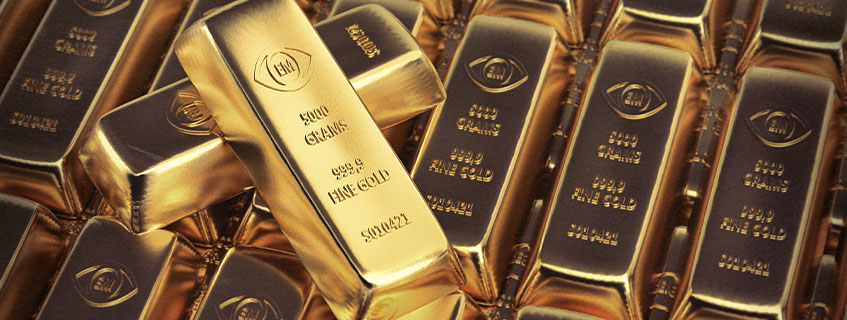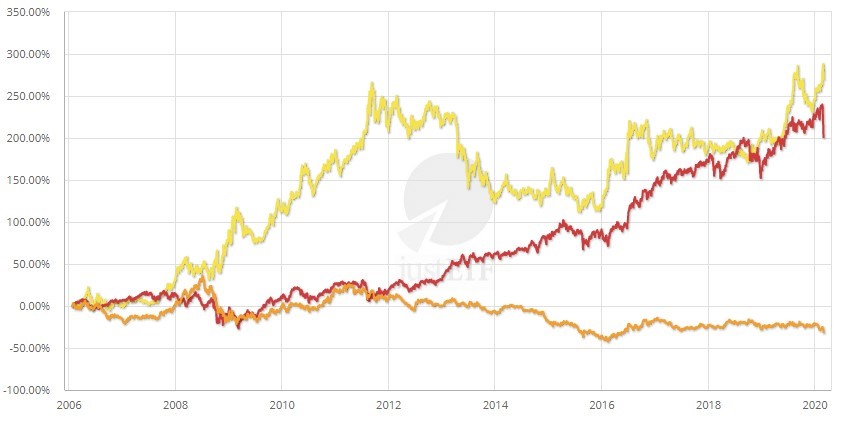
Indeed, part of the pro-gold argument lies in its historical role as a store of value that stretches back from the present day to the dawn of recorded history. That’s a record that bears comparison with the patchy couple of hundred years of returns for equities. Our ancestors loved gold for its rarity, stability, portability, malleability as metal and aesthetic qualities. We still value those properties today. And even though the gold-fevered adventurers of past centuries have been replaced by high-tech mining operations in South Africa and South America, the entirety of the world’s gold supply would melt down into a cube no larger than 21m³. Picture that against the scale of the world’s farmland, or industrial capacity, or the power of central banks to create money out of thin air. The relative resistance of gold to debasement, mass production and consumption, plus its mystique as a barbarous relic all add to its popular potency.
Gold asset allocation
Gold doesn’t spin-off income like equities and bonds. Your future gains rely entirely on selling it for a higher price than you bought it. However, gold has a highly prized property for an asset class: historically, it has exhibited low correlations with equities, bonds and even other commodities.Generally, gold has blazed its own trail regardless of the rise and fall of other asset classes. This feature came into its own during the 2008 financial meltdown when gold made stellar returns as investors feared the worst for other assets – as shown in the chart below.
Asset class correlation 2006-2020 (equities, gold and commodities)

iShares MSCI World UCITS ETF (Dist)
Lyxor Commodities Thomson Reuters/CoreCommodity CRB TR UCITS ETF Acc
Gold Bullion Securities
Lyxor Commodities Thomson Reuters/CoreCommodity CRB TR UCITS ETF Acc
Gold Bullion Securities
Source: justETF Research; as of 29/02/2020; Calculations in GBP
Modern Portfolio Theory tells us that holding a diversified mixture of imperfectly correlated assets can reduce portfolio risk.
A 5-10% gold allocation may, therefore, be appropriate as a form of 'portfolio insurance' because gold’s track record as a store of value over thousands of years confers its safe-haven status during a crisis.
Traditional ways to hold gold
Robber barons and central banks alike traditionally kept the bulk of their gold reserves handy in heavily protected vaults. Why? Because gold is portable, it’s pinchable. Thus you have to pay high costs to keep your physical gold safe – thick walls, laser-triggered alarm systems and slavering guard dogs don’t come cheap. You can keep your coins, bars and jewellery in a bank, or a safe at home backed up by an insurance policy, but those options cost too.Authentication is another drain on your coffers. Whenever physical gold is traded it must be tested for purity. That’s a professional service with a price tag to match.
Some institutions hold tons of gold in their vaults and you can buy a fraction of it. You’ll be recorded as the legal owner although you will never actually see your nuggets. Such services may guarantee quality through tools like the Good Delivery standard of the London Bullion Market Association (LBMA). This standard precisely defines purity, weight and the physical appearance of bars, which are also numbered and registered with the LBMA.
Alternatively, investors can invest in gold mines and gold mining companies by buying their shares on the stock exchange. In doing so, you gain indirect exposure to the gold price as it influences those firms' fortunes. However, the gold price is not the only factor in play. Gold mining companies are highly volatile as their fortunes depend on several risks including management risk, market risk, prospecting risk, political risk, high fixed costs, the oil price, and leverage, among others.
The modern way to invest in gold
For a balanced blend of simplicity, convenience, security and cost-effectiveness it’s hard to beat ETCs (Exchange Traded Commodities) for gold investing. Like ETFs, ETCs are an Exchange Traded Product that you can buy and sell at any time on the stock exchange. But the two products are more like close cousins than identical twins.100% of Gold ETCs exist because European Union regulations require ETFs to invest in a diverse range of securities. ETCs work around this by being debt instruments. Think of them as being more like a bond rather than a fund. The obvious weakness of a bond is that you can lose your money if the issuer defaults. Physical gold ETCs guard against this by being fully backed by actual gold deposits. That collateral is lodged with reputable custodian banks and contractual guarantees ensure the gold is ringfenced for the benefit of the ETC’s shareholders. You can check your ETC’s list of custodians on its website, along with other details such as Good Delivery accreditation and even its inventory of gold bars.
Gold ETC benefits
Gold ETCs have traded on the market since 2003. In March 2020, the weight of all gold bars held by ETCs exceeded 3,000 tons. Accordingly, the assets invested in physically deposited ETCs worldwide amounted to around $150 billion. The key benefits of ETCs are:- Liquidity: Gold ETCs are traded like any other share or ETF on the stock exchange.
- Cheap to own: The annual cost of Gold ETCs range from 0% – 0.59%.
- Cheap to trade: Gold ETC spreads are significantly lower versus coins or bars. This is especially useful if you want to trade often to take advantage of gold price volatility.
- Tracking: Physical gold ETCs track the gold spot price, unlike most synthetic commodity products that are linked to the futures market.
- Transparency: Many providers offer in-depth information online about their gold ETC holdings and custodial arrangements.
- Tax advantage: Gold ETCs can be held in ISAs and SIPPs so you don’t have to pay capital gains when you sell.
- Premium service: Some gold ETC providers will even send your holding to you in pure gold. For a fee, of course.
Gold ETC downsides
Gold trades in US dollars so you’re exposed to currency risk if you expect to pay your bills in British pounds. If the pound weakens, however, currency risk will pull in your favour. Moreover, currency risk can be countered by currency-hedged gold ETCs at a slightly higher total cost ratio (TER).Synthetic gold ETCs are available as well but those require a working knowledge of the futures market to fully understand.
Gold ETCs won’t be much help if you buy into the doomster theory that gold will get you out of trouble during societal turmoil and collapse. You won’t be able to buy food or bribe anyone with a broker’s statement. Still, nobody will rob you for it either.
There’s a chance you can manage a very large holding of physical gold more cheaply by yourself or through a specialist gold owning service – assuming you have the time and expertise to perform due diligence.
Gold ETCs do not pay dividends because gold does not produce income.
The gold price can be highly volatile. However, this can also offer the chance to make profits by buying low and selling high.
Treasure seeking
Ultimately gold is an asset class like no other which is what makes it attractive to investors in the first place. You should weigh up its potential costs and benefits carefully, bearing in mind that its low correlation with other asset classes and its safe-haven status are the main USPs. And last but not least, you can use ETCs to gain exposure to an asset which most of our forebears could only dream of.Top Gold ETCs in comparison
Search for Gold ETCs in the ETF search















